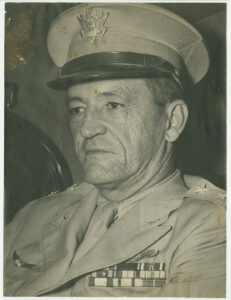General Claire Chennault and the Flying Tigers
During World War II General Claire Chennault led the Flying Tigers, a group of American volunteer pilots who assisted the Chinese Air Force.

The Historic New Orleans Collection
Portrait of Major General Claire L. Chennault, 1945.
Louisianan Claire Lee Chennault’s military career seemed over when he retired from the United States Army in 1937, but World War II afforded him the opportunity to contribute to the Allied victory over Japan. He backed the idea that pursuit or fighter aircraft could achieve useful results in warfare at a time when Army Air Corps commanders believed that high-altitude bombers could achieve better results. After leaving the Air Corp, he traveled to China, where he was an adviser to General and Madame Chiang Kai-Shek and adviser-trainer for the Chinese Air Force as they tried to fend off the Japanese invasion of China prior to World War II. He also lobbied the American government to send aircraft and supplies to replace obsolete aircraft and equipment lost in the war with Japan. Beginning in early 1941, Chennault led the Flying Tigers group of American volunteers who assisted the Chinese Air Force, and he commanded the official army units that replaced the Flying Tigers in 1942.
General Chennault
Chennault studied at Louisiana State University, where he trained with the Reserve Officer Training Corps (ROTC). He then entered the teacher education program at Louisiana State Normal School in Natchitoches (now Northwestern State University of Louisiana), which prepared him to become a teacher in Claiborne Parish. He met his first wife, Nell Thompson, while in Natchitoches, and the couple moved to New Orleans, where he earned a typing diploma and worked at the local YMCA.
The couple moved to Akron, Ohio, in 1916, and Chennault found work at the Goodyear Tire & Rubber Company inspecting blimp-like surveillance balloons. He had first witnessed flight at the Louisiana State Fair in Shreveport in 1910, and the physical act of flying intrigued him. He applied to become an army pilot in 1917 but was rejected because he did not meet the stringent requirements. He joined the infantry instead, but was transferred to the Aviation Division of the Army Signal Corps. He completed pursuit pilot training in 1922 and served as chief of the pursuit section of the Army Air Corps Tactical School during the 1930s. He became increasingly convinced that fighters could serve with great success in aerial combat.
Chennault resigned from the military in 1937 due to struggles with chronic bronchitis and increasing deafness from flying in open and cold cockpits, along with disputes with his commanders who believed in the utility of bombers over fighters. He was soon recruited to assist Chinese air defenses against Japan.
The Flying Tigers
Claire Chennault’s new position as aviation adviser to General Chiang Kai-shek gave him direct insight into the Chinese Air Force’s inability to defend the country against Japanese attack. His efforts to rebuild Chinese air power and create effective defenses led to creation of the American Volunteer Group (AVG), known as the Flying Tigers, in 1941. The pilots included Americans trained by Chennault in his fighting techniques.
Their successes against Japanese air forces in Burma beginning shortly after the Pearl Harbor attack lifted American spirits. Defense of the Burma Road— which prevented complete isolation of China, protected the Chinese capital city of Chungking, and led to victories in Chinese airspace—created a heroic image of the Tigers early in the war. This was bolstered by their Curtiss P-40 fighters, painted with their famous shark-nose emblems. Reports of the Flying Tigers successfully dueling with Japanese air forces provided a bit of good news when reports from other war fronts included depressing accounts of Allied setbacks.
Chennault taught his pilots to use aerial tactics that were unlike those of the US or British air forces. His method called for attacking the more maneuverable and numerous Japanese airplanes from above rather than engaging in a typical dogfight of turn and thrust. Pilots learned to dive away after their initial attack and maneuver into a superior position for another dive.
The Flying Tigers were incorporated into the US Army Air Force in 1942, and Chennault was recalled to active duty. The Flying Tigers unit became the China Air Task Force and was later renamed the Fourteenth Air Force. Some of the original Flying Tigers continued with the group during these transitions, but others preferred to leave for other projects. By the time the AVG was folded into the American military, it was credited with destroying 296 Japanese aircraft with the loss of only 14 of its pilots in combat. Chennault was promoted to major general in 1943, but continued disagreements with General Joseph Stilwell, American commander in China, and other commanders led him to resign his commission in 1945.
Post-War Years
Claire Chennault returned to China and established a commercial airline in 1946. His marriage to Nell Thompson ended in divorce, and he married Chen Xiangmei (known as Anna Chennault), in 1947. His Civil Air Transport took to the skies in 1948 and carried troops, munitions, and supplies for the Nationalist Chinese government and apparently for the Central Intelligence Agency until the Nationalist government retreated to the island of Formosa.
Chennault received a promotion to the honorary rank of lieutenant general nine days before his death of cancer in Ochsner Foundation Hospital in New Orleans on July 27, 1958. He is buried in Arlington National Cemetery in Arlington, Virginia.
Recognitions of General Chennault include Lake Charles Air Force Base, which was renamed Chennault Air Force Base after his death until its closure in 1963; a commemorative postage stamp issued in 1990; and his induction into the National Aviation Hall of Fame in Dayton, Ohio, in 1972. The Chennault Aviation and Military Museum opened in 2000 in the last remaining building of the Selman Field Navigation School in Monroe and houses artifacts related to General Chennault and the Flying Tigers as well as other military artifacts.
